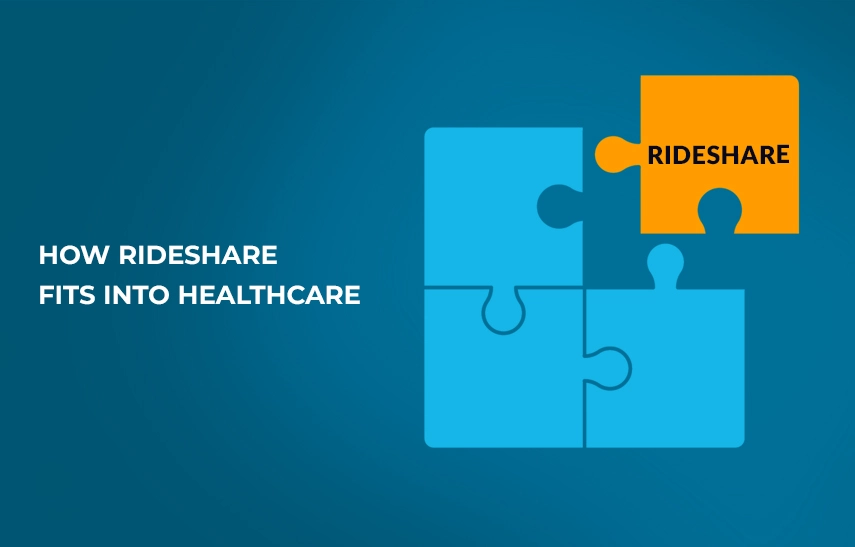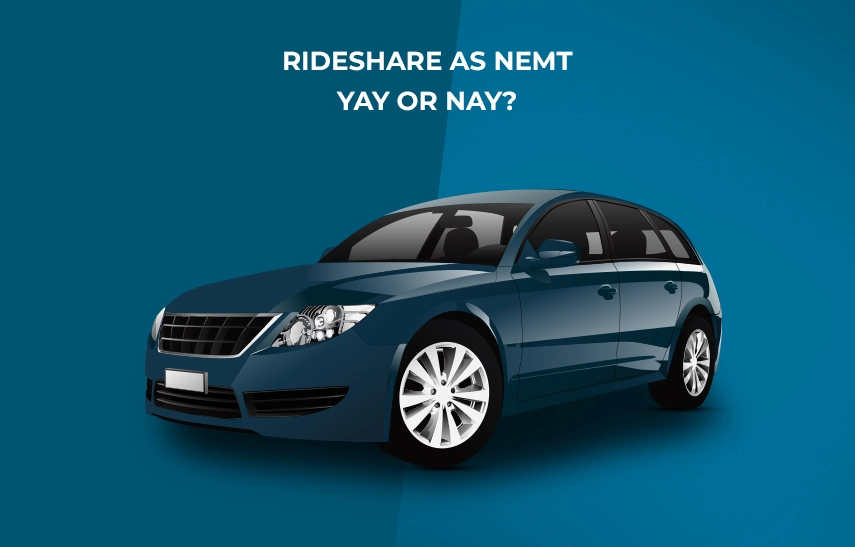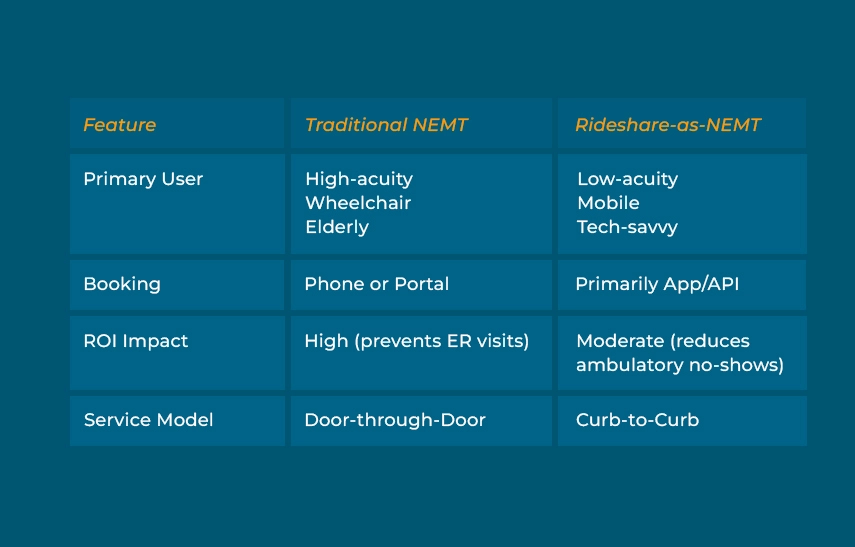NEMT vs. Ridesharing: Medical Transportation Rivals or Future Partners?

For those who don't drive, Non-Emergency Medical Transportation (NEMT) isn’t just a convenience; it’s what makes healthcare possible. NEMT is a service that allows scores of people across the U.S. to reach their healthcare appointments safely and on time.
In recent years, however, rideshare platforms such as Uber Health and Lyft Healthcare have also entered the medical transportation space. This overlap of services has raised one crucial question:
Do these services rival each other, or will their co-existence and cooperation be crucial to satisfy the growing demand for medical transportation of the aging nation?
In this blog, we explore NEMT vs. rideshare as well as dissect how they fit into the overall medical transportation arena.
Contents:
- How Rideshare Fits Into Healthcare
- Rideshare-as-NEMT vs. Traditional NEMT: Differences Explained
- Benefits and Limitations of Merging Ridesharing and NEMT Services
- Ridesharing and NEMT: the Hybrid Model Is Inevitable and Necessary
How Rideshare Fits Into Healthcare

Rideshare services first emerged in the early 2010s. Initially, they were designed as basic app-based transport services that provided quick transport using personal vehicles. Over time, these platforms evolved to include several other features such as scheduled rides, business accounts, and fleet options.
A few years ago, both Uber and Lyft identified a gap in the transportation industry: An increasing number of missed medical appointments. This led to Lyft Healthcare partnering with Medicaid, Managed Care Organizations, and non-profits as early as 2016. Uber Health also launched a platform for hospitals, clinics, and care managers to book rides on behalf of patients back in 2018.
These services target a specific niche: ambulatory NEMT. Ambulatory patients are those who need a ride but don’t require any additional assistance, equipment, or medical supervision.
Rideshare-as-NEMT vs. Traditional NEMT: Differences Explained
At first glance, both rideshare and NEMT seem to be doing the same thing. However, there are specific differences:
What is each best for?
Ridesharing NEMT services are designed for ambulatory passengers, those who can walk independently and don’t require any mobility aids or personal assistance.
Traditional NEMT providers serve both ambulatory passengers as well as individuals who use wheelchairs, require stretchers, or need support during pick-up and drop-off.
Assistance level
Rideshare drivers may be, but are not required to be, trained to assist passengers. If they have time in between orders or want to go above and beyond, then rideshare drivers will help passengers into buildings or even up the stairs. However, their responsibility essentially ends at the curb. This may pose a big challenge for passengers who are elderly, frail, or have any type of cognitive impairment.
Conversely, traditional NEMT service drivers are trained for this, and such assistance is within their job description. They usually provide door-to-door as well as door-through-door assistance. This means that the passenger will be assisted right to their door, and even inside.
Vehicle accessibility
Most rideshare vehicles are sedans that simply cannot accommodate wheelchairs. This is especially true for services outside major cities.
NEMT fleets, however, are built with accessibility in mind. There are wheelchair-accessible vehicles (WAVs), stretcher vans, as well as lift-equipped vehicles to accommodate a variety of physical needs. NEMT vans can also be fully equipped with oxygen mounts, first aid kits, and other essential tools that ensure the safety and comfort of passengers during transport.
Driver training
Rideshare drivers typically receive only general customer service training. They are not required to be trained in handling any medical situations, how to service vulnerable passengers, or how to act during medical emergencies.
In contrast, NEMT drivers will often undergo training in CPR, patient handling, HIPAA compliance, and disability awareness.
Scheduling and dispatch
NEMT providers schedule rides through dispatch software. These complex systems include compliance features and are often integrated with billing workflows.
Rideshare services typically offer API-based scheduling platforms that are used to book, track, and manage rides online. This software can be integrated with the NEMT platforms for seamless involvement of contractors who specialize in ridesharing but also offer ambulatory NEMT.
Interestingly, this ease of digital cooperation opens up a great opportunity for these services to coexist and flourish in the future
Benefits and Limitations of Merging Ridesharing and NEMT Services

The demand for medical transportation is on the rise, but due to Medicaid and Medicare cuts, providers cannot expect noticeable rate increases. Therefore, the healthcare transportation system needs to find ways to satisfy the demand without going bankrupt in the process.
Cooperation between non-emergency medical transportation providers and ridesharing platforms is a promising avenue for a more efficient business model.
The top advantages of rideshare-as-NEMT include:
1. Flexibility and Scalability
Rideshare platforms allow making real-time or pre-scheduled bookings through digital dashboards. This makes it easier to manage last-minute needs or overflow capacity. NEMT providers who see a spike in ambulatory medical transportation requests but do not have enough in-house vehicles can easily outsource these to ridesharing.
2. Cost Savings
Rideshares can be more affordable in situations where the distance is shorter and the passenger is also ambulatory. This frees up fleet vehicles for more lucrative orders that require transportation of passengers with low mobility or high acuity.
Instead of overstressing traditional NEMT providers, the healthcare industry should encourage the integration of ridesharing into NEMT workflows to prevent missed medical appointments that cost the US healthcare system approximately $150 billion annually.
3. Better Access in Urban Areas
There are more drivers available in urban areas. Instead of routing drivers through congested traffic and accumulating deadhead miles, providers can push the request to rideshare. This makes rideshares particularly useful in cities by reducing no-shows and wait times. A passenger who cancels a ride or leaves a complaint about a long wait time is not only a lost opportunity but also a liability for a provider.
Limitations of rideshare-as-NEMT
Despite the obvious convenience, ridesharing NEMT services come with critical constraints that cannot be ignored.
1. No Support for Wheelchair or Stretcher Needs
While some platforms claim to offer rideshare wheelchair-accessible options, their availability is extremely limited.
2. Lack of Driver Training
Rideshare drivers aren’t typically trained to handle elderly, disabled, or medically vulnerable passengers. There is also no standard protocol for handling patient emergencies.
3. Curb-to-Curb Only
Rideshare services come under curb-to-curb medical transportation. For patients with limited mobility, cognitive impairments, or vision issues, this can become a safety concern.
4. Limited Rural Coverage
In many rural areas, rideshare isn’t available. Here, wait times can be unpredictable, or providers may not accept rural pickups at all. This makes it unreliable for Medicaid or recurring transport needs.
5. Regulatory & Liability Considerations
Regulatory and liability constraints often limit rideshare use in medical transportation. SMAs and NEMT brokers require background checks, medical transport insurance, vehicle inspections, HIPAA and patient safety training, and performance oversight that rideshare platforms may not consistently guarantee.
Liability is also less defined, covering missed appointments, patient injuries in non-accessible vehicles, and Protected Health Information (PHI) handling, making rideshare a higher-risk option for brokers and healthcare organizations compared to established NEMT providers.
Ridesharing and NEMT: the Hybrid Model Is Inevitable and Necessary
 Ridesharing isn’t a replacement for traditional NEMT. However, ridesharing has introduced flexibility into healthcare transportation that has been struggling with low reimbursement rates and constantly growing demand.
Ridesharing isn’t a replacement for traditional NEMT. However, ridesharing has introduced flexibility into healthcare transportation that has been struggling with low reimbursement rates and constantly growing demand.
Medical transportation industry experts foresee a rise in ridesharing utilization in ambulatory trips and see it as a tool for traditional providers to improve their bottom line and service reliability. However, they also see a need to resolve liability issues and risks.
In today’s environment, it is crucial to treat ridesharing as a powerful tool to improve the efficiency of your medical transportation business and never fail passengers or healthcare systems that rely on you. As a provider, understanding distinctions between NEMT vs. ridesharing helps you adapt and scale without compromising on your service quality.
If you're looking to manage your NEMT operations more effectively and seamlessly work with ridesharing platforms, you can check out RouteGenie. Our software is built specifically for NEMT providers. From scheduling and dispatch to driver tracking, billing, and compliance, we help you run a smarter, more connected transportation business.
FAQ Ridesharing vs. NEMT
Are Uber or Lyft rides safe for elderly or disabled patients?
Often yes for ambulatory riders. If someone needs physical help, a wheelchair/stretcher vehicle, or supervision, traditional NEMT is usually a better fit.
Are rideshare services reliable for recurring NEMT appointments?
Yes, for ambulatory riders, especially with advance scheduling and good driver supply. For standing orders or riders who need assistance, traditional NEMT is often more consistent.
What does “curb-to-curb” transportation mean?
Curb-to-curb transportation is when a driver picks up and drops off the passenger at the curb without offering assistance into buildings or medical facilities.
About the author

As RouteGenie's Marketing Director, Yurii gained deep knowledge in the NEMT industry. He is an expert in marketing, utilizing all marketing channels to build RouteGenie's brand and to make sure NEMT providers have access to powerful NEMT software that can boost their growth. Yurii shares his knowledge by writing content on topics related to marketing, and the healthcare industry: medical transportation, home care, and medical billing.
The author assumes no responsibility or liability for any errors or omissions in the content of this site. The information contained in this site is provided on an "as is" basis with no guarantees of completeness, accuracy, usefulness or timeliness.